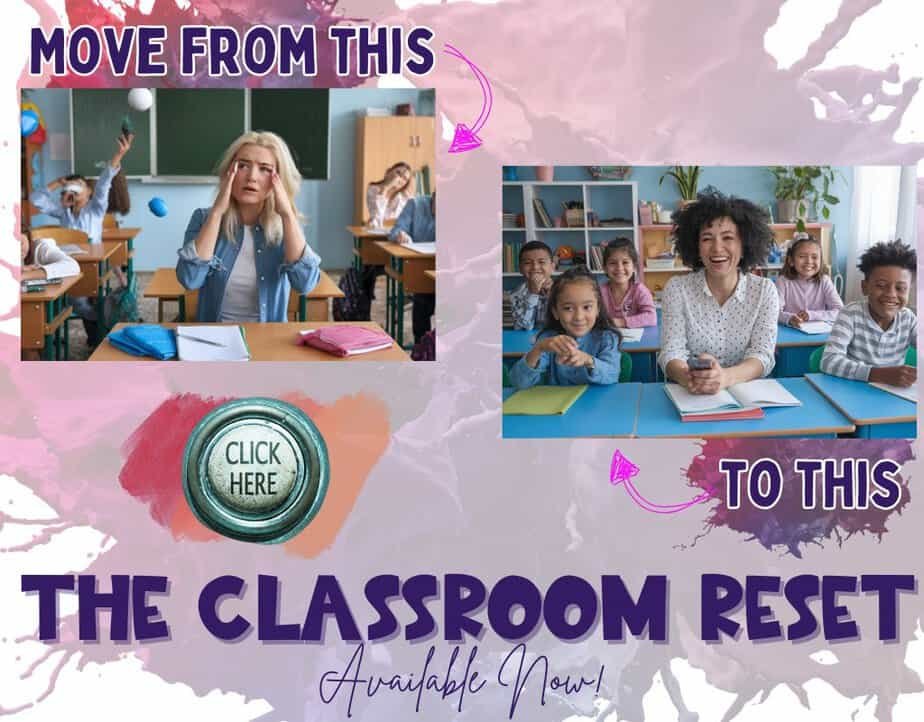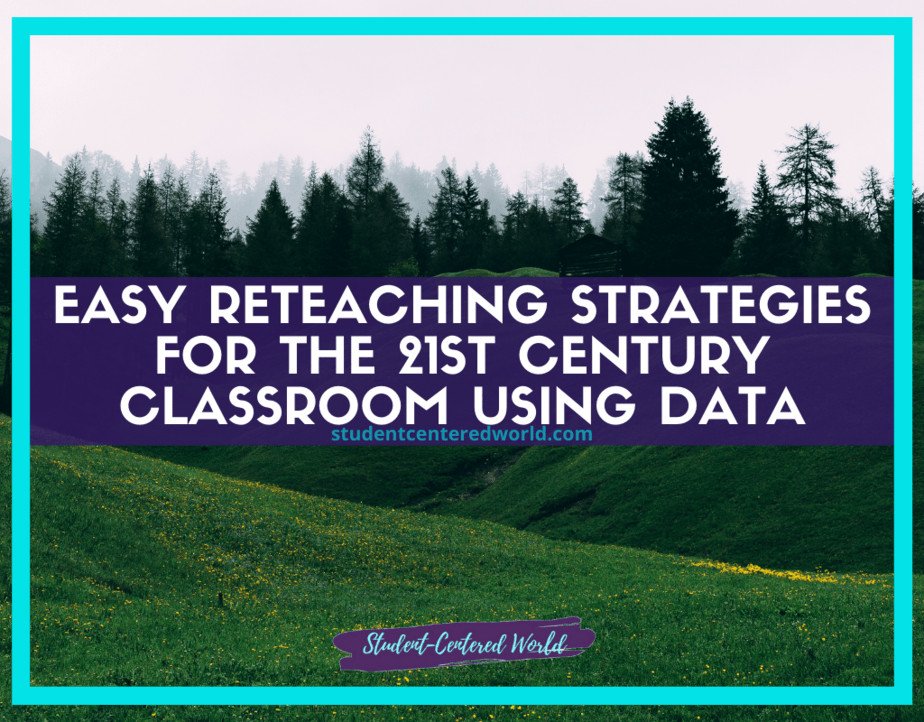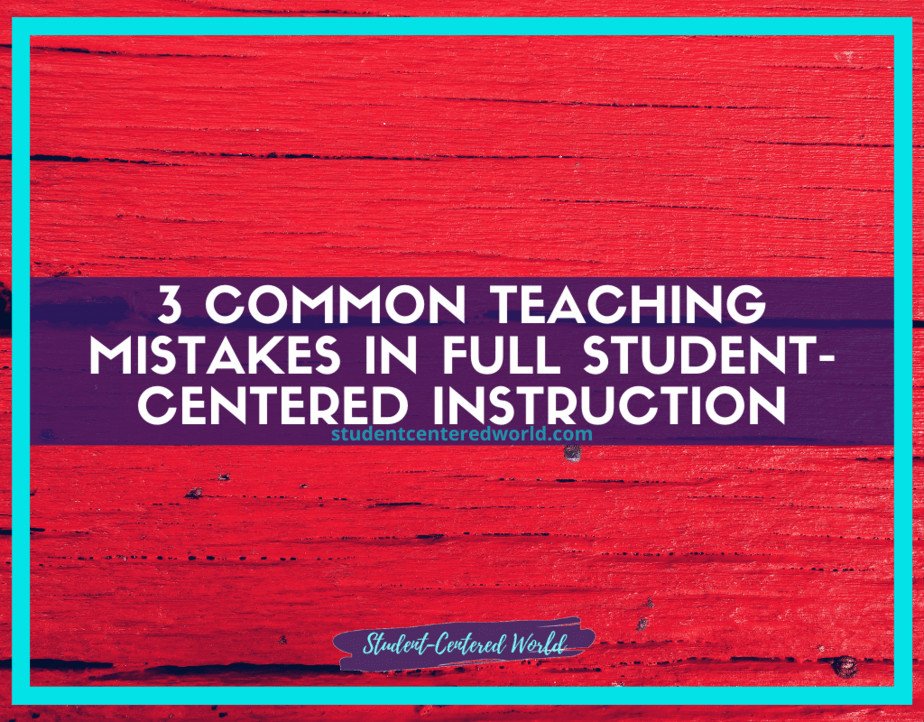Learned Helplessness to Resilience: What Psychology Shows
Learned helplessness is a psychological condition where individuals, after repeated exposure to uncontrollable events, develop a sense of helplessness and stop trying to change their circumstances, even when opportunities arise. This concept was first introduced by Martin Seligman and Steven Maier in the late 1960s at the University of Pennsylvania through experiments with dogs in a shuttle box. The dogs subjected to inescapable shocks eventually stopped trying to escape, even when given the chance, a behavior later linked to human behaviors in similar situations.
The original theory suggests that when people (or animals) perceive a lack of control over negative events, they may develop cognitive deficits, low self-esteem, and a pessimistic explanatory style, believing that bad outcomes are inevitable. Over a long time, this can lead to depressive symptoms, academic achievement struggles, and even clinical depression.
Recent studies have identified brain mechanisms (like the dorsal raphe nucleus and ventromedial prefrontal cortex) that reinforce this mental state.
Overcoming Learned Helplessness in Elementary School (Ages 5–10)
Learned helplessness in young children can manifest as a reluctance to try new tasks, excessive dependence on adults, or frustration when faced with challenges. Because elementary-aged students are still developing their cognitive and emotional regulation skills, they are particularly vulnerable to adopting a pessimistic explanatory style, believing that failure is permanent and uncontrollable.
However, teachers can counteract this mindset by fostering self-efficacy, resilience, and an internal locus of control. Below are research-backed strategies tailored for elementary classrooms.
1. Building a Sense of Control with Low-Barrier Tasks
One of the most effective ways to combat learned helplessness is to provide students with achievable challenges that allow them to experience success quickly. When children repeatedly face tasks that feel insurmountable, they develop a sense of hopelessness, reinforcing the belief that effort doesn’t matter.
Strategies for Implementation:
- Choice Boards: Offer students multiple ways to complete an assignment (e.g., drawing, writing, or verbally explaining an answer). This empowers them to select a method that aligns with their strengths.
- Scaffolded Tasks: Break assignments into smaller, manageable steps. For example, instead of saying, “Write a story,” guide them through brainstorming, drafting, and revising.
- Quick Wins: Start lessons with simple review questions to build confidence before introducing harder material.
Why It Works:
Research by Seligman & Maier shows that when individuals (or animals, as in their shuttle box experiments) perceive a lack of control, they stop trying. By contrast, low-barrier tasks help children realize that their actions lead to positive outcomes, reinforcing motivation.
2. Reframing Negative Events with Optimistic Explanations
Children who attribute failures to internal, permanent causes (e.g., “I’m just bad at math”) are more likely to develop helpless behavior. Teachers can shape a healthier mindset by modeling an optimistic explanatory style, framing setbacks as temporary and changeable.
Strategies for Implementation:
- Growth Mindset Language:
- Instead of: “You got this wrong.”
- Try: “Mistakes help us learn! Let’s see where we can improve.”
- Normalize Struggle: Share stories of famous figures (e.g., Thomas Edison, J.K. Rowling) who failed before succeeding.
- Process Praise: Focus on effort rather than innate ability:
- “You worked so hard on this!” instead of “You’re so smart!”
Why It Works:
Studies on characteristic explanatory styles show that children who believe effort leads to improvement (rather than fixed ability) persist longer in difficult situations. This aligns with Carol Dweck’s research on a growth mindset.
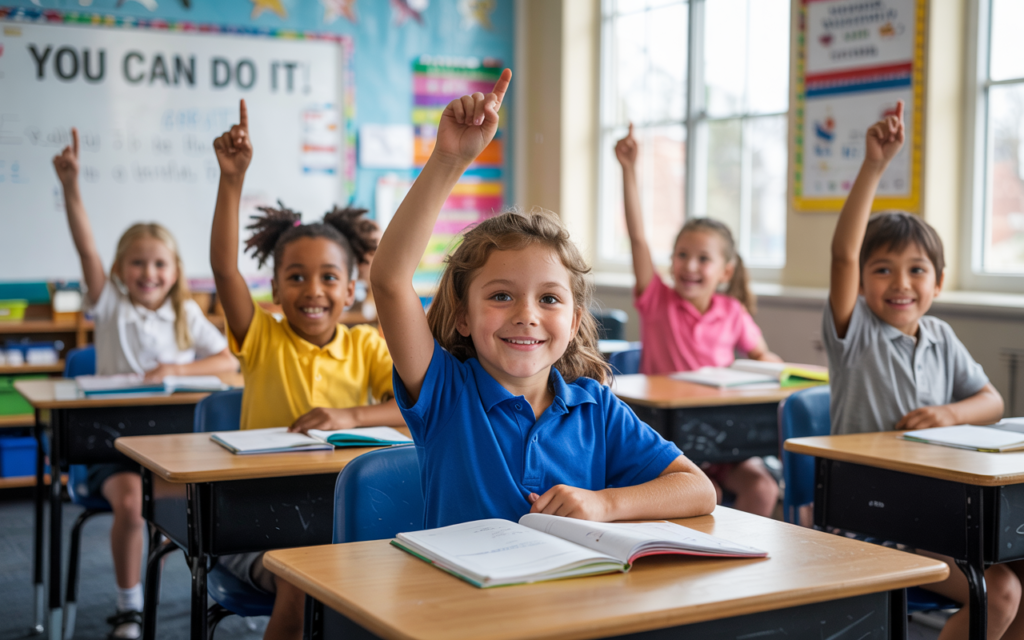
3. Using Positive Reinforcement to Reward Effort
When children receive praise only for correct answers, they may avoid challenges to prevent failure. Instead, reinforcing effort, strategy, and persistence helps them associate hard work with success.
Strategies for Implementation:
- Effort-Based Rewards: Give stickers or verbal praise for attempting a difficult problem, even if the answer is wrong.
- Progress Tracking: Use visual charts to show improvement over time (e.g., “Look how many more words you can read now!”).
- Peer Recognition: Encourage classmates to applaud each other’s perseverance (e.g., “I saw how hard Maria worked on her project!”).
Why It Works:
Martin Seligman’s work in positive psychology highlights that focusing on strengths (rather than deficits) improves mental health and motivation. Additionally, behavioral psychology shows that reinforcement strengthens desired behaviors.
4. Encouraging Play-Based Problem-Solving
Play is a natural way for children to experiment, fail, and try again in a low-stress environment. Structured play activities can rebuild confidence and reduce stress levels associated with academic pressure.
Strategies for Implementation:
- Collaborative Games: Team-based puzzles or building challenges teach that mistakes are part of learning.
- Role-Playing Scenarios: Have students act out situations where they “try again” after failure (e.g., a character keeps practicing a skill until they succeed).
- STEM Challenges: Simple experiments (e.g., “Build a bridge with straws”) encourage trial-and-error thinking.
Why It Works:
Neuroscience research shows that play activates the ventromedial prefrontal cortex, which helps regulate emotions and decision-making. Additionally, Steven Maier’s later work found that perceived control over aversive stimuli reduces helpless behavior.
5. Addressing Emotional Barriers to Learning
Some children develop learned helplessness due to past experiences (e.g., trauma, domestic violence, or academic struggles). Teachers must create a safe, supportive environment where students feel capable of overcoming challenges.
Strategies for Implementation:
- Mindfulness Exercises: Short breathing activities can help students reset after frustration.
- Safe Failure Zones: Normalize mistakes by saying, “In this class, we learn from errors!”
- One-on-One Check-ins: Privately ask struggling students, “What part feels hardest? How can I help?”
Why It Works:
Children with low self-esteem often shut down when facing adverse situations. By providing social support and emotional safety, teachers help rewire the brain’s response to stress, as seen in studies on the dorsal raphe nucleus and resilience.
Learned helplessness doesn’t develop overnight, it’s a learned behavior shaped by repeated uncontrollable events. However, elementary teachers have the unique opportunity to reverse this pattern by:
- Providing achievable challenges (low-barrier tasks).
- Reframing failures as learning opportunities.
- Rewarding effort over perfection.
- Using play to rebuild confidence.
- Addressing emotional barriers with empathy.
By implementing these strategies, educators can help students shift from “I can’t” to “I’ll try again,” setting the foundation for academic achievement and lifelong resilience.
The greatest weapon against learned helplessness is the belief that effort matters. In the elementary classroom, every small victory plants the seed of perseverance.
Overcoming Learned Helplessness in Middle School (Ages 11–14)
Middle school is a critical period for cognitive and emotional development, where students begin forming lasting beliefs about their abilities. At this stage, learned helplessness often emerges as disengagement, avoidance of challenges, or self-defeating statements like “I’m just bad at this.” Unlike elementary students, adolescents are more aware of social comparisons, making them prone to pessimistic explanatory styles, attributing failures to fixed traits rather than effort.
However, targeted interventions can help them develop resilience, self-directed learning, and an internal locus of control. Below are research-based strategies tailored for middle school classrooms.
1. Challenging Pessimistic Thinking with Cognitive Behavioral Techniques
Middle schoolers often internalize failure, leading to cognitive deficits in problem-solving. Cognitive Behavioral Therapy (CBT) techniques can help them reframe negative thought patterns.
Strategies for Implementation:
- Thought Records: Have students jot down automatic thoughts (e.g., “I’ll never understand math”) and challenge them with evidence (“I solved three problems correctly yesterday”).
- The “Three C’s” Exercise: Teach students to:
- Catch the negative thought.
- Check its accuracy.
- Change it to a growth-oriented one (“This is tough, but I can ask for help”).
- Socratic Questioning: Ask, “What’s the evidence for this thought? Is there another explanation?”
Why It Works:
The learned helplessness model of depression (Seligman, 1975) shows that negative self-talk reinforces helplessness. CBT interrupts this cycle by fostering optimistic explanatory styles, which correlate with better academic performance and mental health (Seligman & Maier, 1967).
2. Group Work with Assigned Roles to Foster Responsibility
Middle schoolers crave autonomy but often doubt their competence. Structured group work with clear roles (e.g., leader, recorder, timekeeper) gives them personal responsibility and reduces reliance on adults.
Strategies for Implementation:
- Jigsaw Method: Assign each student a unique piece of content to teach peers, ensuring interdependence.
- Rotating Leadership: Switch roles weekly so all students experience decision-making.
- Peer Feedback: Teach constructive critique (“Your idea is strong, maybe add an example?”) to build effective communication.
Why It Works:
Steven F. Maier’s neuroscience research shows that perceived control activates the ventromedial prefrontal cortex, reducing stress. Group accountability mirrors real-world collaboration, combating personal helplessness (Peterson et al., 1993).
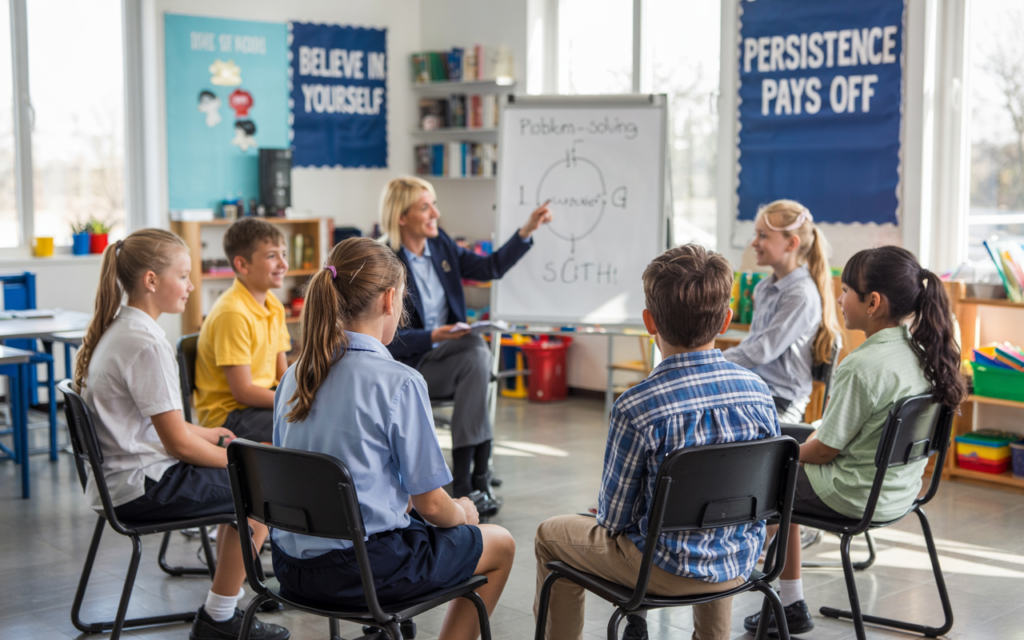
3. Connecting Lessons to Students’ Interests and Real-World Scenarios
Disengagement peaks in middle school when students ask, “Why does this matter?” Linking curriculum to their students’ interests (e.g., sports, social media, gaming) boosts motivation.
Strategies for Implementation:
- Interest Surveys: Ask students what topics excite them and design projects around them (e.g., math lessons using sports statistics).
- Problem-Based Learning (PBL): Present real-world challenges (e.g., “Design a budget for a school event”).
- Guest Speakers: Invite professionals to explain how they use academic skills daily.
Why It Works:
When learning feels relevant, students shift from “I have to” to “I want to.” Studies on inquiry-based learning show that interest-driven tasks improve academic growth and reduce helpless behavior (Hmelo-Silver, 2004).
4. Teaching Coping Strategies Through Role-Playing
Middle schoolers face adverse situations (bullying, academic pressure) but often lack the tools to respond. Role-playing equips them with effective actions.
Strategies for Implementation:
- Bullying Scenarios: Act out responses to teasing (e.g., humor, assertiveness) and discuss outcomes.
- Failure Simulations: Normalize mistakes by having students “fail” a task and brainstorm fixes.
- Stress-Relief Practices: Teach quick techniques (e.g., box breathing, positive self-talk).
Why It Works:
Seligman & Maier’s research on inescapable shock versus controllable stress shows that practicing defensive strategies reduces a sense of hopelessness. Role-playing also builds social support, a buffer against depressive symptoms (Bandura, 1997).
5. Addressing Emotional and Social Barriers
Many middle schoolers with low self-esteem withdraw after negative events. Teachers must create a classroom culture that normalizes struggle.
Strategies for Implementation:
- Mistake Journals: Have students reflect on errors and lessons learned.
- Peer Mentoring: Pair struggling students with empathetic classmates.
- Teacher Vulnerability: Share personal stories of overcoming challenges.
Why It Works:
Recent studies on the dorsal raphe nucleus show that social support mitigates stress responses. Normalizing struggle aligns with positive psychology, fostering resilience (Seligman, 2011).
Conclusion: Empowering Adolescents to Take Control
Middle schoolers are at a pivotal stage where learned helplessness can solidify, or be overturned. By:
- Teaching CBT techniques to reframe negativity.
- Structuring group work for accountability.
- Linking lessons to passions to ignite engagement.
- Role-playing coping strategies for real-life challenges.
- Building emotional safety nets through peer and teacher support.
Educators can transform “I can’t” into “I’ll try a different way”. The middle school mind is a garden: nurture resilience now, and it will flourish for a lifetime.
Combating Learned Helplessness in High School (Ages 15-18): Cultivating Agency and Resilience
1. Promoting Self-Directed Learning Through Authentic Research
High school students stand at the precipice of adulthood, making this the ideal time to develop self-directed learning skills that counteract personal helplessness. By allowing students to investigate real-world issues like domestic violence, social support systems, or mental health stigma, we empower them to see knowledge as a tool for change rather than passive absorption.
Implementation Strategies:
- Passion Projects: Students select a societal issue tied to learned helplessness, research root causes, and propose solutions (e.g., creating a peer support program to combat a sense of hopelessness)
- Community Partnerships: Collaborate with local organizations working on these issues to add real-world stakes
- Multimedia Presentations: Students share findings through TED-style talks, podcasts, or documentary films
Why It Works:
Neuroscience research shows that the ventromedial prefrontal cortex (involved in decision-making) becomes more active when individuals perceive meaningful control. The original researchers (Seligman & Maier) found that uncontrollable events create helplessness, while self-directed projects restore agency.
2. Mastering Explanatory Styles Through Meta-Cognition
By high school, students’ characteristic explanatory styles are often entrenched. Deliberate practice in analyzing and reframing thought patterns can literally rewire their responses to adverse situations.
Implementation Strategies:
- Thought Experiments: Analyze historical figures’ responses to failure (e.g., comparing Edison’s 10,000 attempts to a student who gives up after two)
- Failure Résumés: Students document their biggest flops and what they learned (turns negative events into growth opportunities)
- Cognitive Journaling: Weekly reflections tracking automatic thoughts about academic challenges
Why It Works:
Studies on optimistic explanatory style show it reduces depressive symptoms by 32% in adolescents (Seligman, 2006). When students internalize that bad events are often temporary and changeable, they develop an internal locus of control.
3. Simulating Controllable Challenges Through Academic “Stress Inoculation”
Unlike the inescapable shocks in Seligman’s experiments, well-designed classroom challenges provide perceived control, the antidote to helplessness.
Implementation Strategies:
- Policy Debates: Structured competitions where preparation directly correlates with success
- Entrepreneurial Simulations: Student teams launch mock businesses with variable outcomes based on decisions
- Graded Drafts System: Multiple submission opportunities with clear rubrics showing how much effort improves outcomes
Why It Works:
The shuttle box experiments proved that escapable shocks don’t produce helplessness. Similarly, academic challenges with transparent cause-and-effect relationships build effective action pathways in the brain (Maier, 2016).
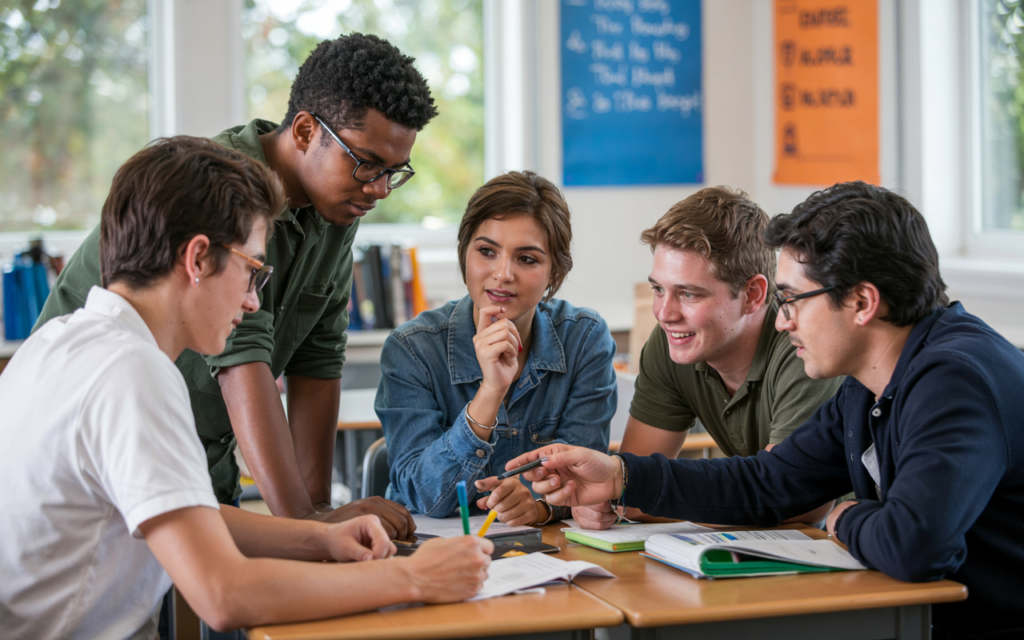
4. Highlighting Role Models Who Transcended Adversity
At this developmental stage, students need narratives that combat the sense of hopelessness pervasive in modern media.
Implementation Strategies:
- Case Study Analysis: Deep dives into figures like Malala (education activist) or Einstein (learning differences)
- Local Hero Spotlights: Invite community members who have overcome traumatic events to share their stories
- “Adversity Résumés” of successful professionals showing their early struggles
Why It Works:
Recent studies on post-traumatic growth show that exposure to recovery narratives activates the dorsal raphe nucleus differently than helplessness narratives, building neural resilience (Maier & Seligman, 2016).
5. Integrating Positive Psychology Interventions
Beyond academics, explicit training in psychological tools prepares students for future challenges.
Implementation Strategies:
- Mental Fitness Drills: Weekly 10-minute exercises from positive psychology research
- Stress Inoculation Training: Gradual exposure to academic stressors with coping tools
- Peer Coaching Programs: Upperclassmen mentor underclassmen using CBT techniques
Why It Works:
The learned helplessness model of depression shows that prevention is more effective than treatment. These proactive measures build the ventromedial prefrontal cortex’s regulatory capacity before crises hit.
Preparing Warriors, Not Worriers
High school educators have the unique opportunity to transform learned helplessness into learned resilience by:
- Replacing passive learning with self-directed mastery experiences
- Making explanatory style analysis a core thinking skill
- Designing challenges that prove effort matters
- Providing concrete examples of overcoming adverse conditions
- Equipping students with psychological tools for future challenges
The teenage brain is primed for revolution against limitations, against hopelessness, against helplessness. Our classrooms can be the training grounds for this positive uprising.
Core Strategies for Every Developmental Stage
Educators working with students at any level, elementary, middle, or high school, can combat learned helplessness by implementing key universal principles. One essential strategy is to embrace productive struggle, avoiding helicopter teaching and allowing students to grapple with challenges. Temporary discomfort fosters resilience and demonstrates that effort leads to growth.
For example, instead of immediately correcting errors, teachers can ask probing questions like, “What’s another approach you could try?”
Another critical approach is to chunk tasks into manageable steps, breaking assignments into clear, sequential goals to prevent overwhelm and showcase progress. Checklists for multi-step projects, paired with celebrating each completed phase, can reinforce this method.
Additionally, prioritizing reflective practice helps reinforce an internal locus of control by guiding students to analyze setbacks. Questions like “What worked? What would you change next time?” encourage self-assessment. Weekly peer discussions on “failures and fixes” can further normalize iterative learning.
To support emotional regulation, educators should integrate mindfulness techniques, such as breathing exercises or grounding strategies, particularly for students experiencing stress from trauma or perceived loss of control. A simple 2-minute mindfulness pause before high-stakes tasks can set a calmer tone for learning.
The Lifelong Impact of Empowerment
If left unaddressed, learned helplessness can escalate into depressive symptoms, PTSD, or chronic underachievement. However, classrooms that champion personal responsibility and effective actions become incubators for resilience. Educators can foster this by modeling optimistic explanatory styles (“Mistakes are data, not destiny”), designing scaffolded challenges that prove effort matters, and creating psychologically safe spaces for struggle.
These practices help students reinterpret adversity as an opportunity for growth, shifting their mindset from “I can’t” to “I’ll try.” Ultimately, students internalize a fundamental truth: they hold the power to influence their outcomes.
Education’s highest calling isn’t just imparting knowledge, it’s lighting the flame of agency. Every small victory over helplessness today plants the seeds for tomorrow’s resilient leaders.
Works Cited
Dweck, Carol S. Mindset: The New Psychology of Success. Random House, 2006.
Hattie, John. Visible Learning: A Synthesis of Over 800 Meta-Analyses Relating to Achievement. Routledge, 2009.
Kapur, Manu. “The Preparatory Effects of Problem Solving versus Problem Posing on Learning from Instruction.” Learning and Instruction, vol. 39, 2016, pp. 23–31, doi:10.1016/j.learninstruc.2015.05.004.
Perry, Bruce D. “Applying Principles of Neurodevelopment to Clinical Work with Maltreated and Traumatized Children.” Working with Traumatized Youth in Child Welfare, edited by Nancy Boyd Webb, Guilford Press, 2006, pp. 27–52.
Seligman, Martin E. P., and Steven F. Maier. “Failure to Escape Traumatic Shock.” Journal of Experimental Psychology, vol. 74, no. 1, 1967, pp. 1–9, doi:10.1037/h0024514.
Vygotsky, Lev S. Mind in Society: The Development of Higher Psychological Processes. Harvard University Press, 1978.
Yeager, David S., and Carol S. Dweck. “Mindsets That Promote Resilience: When Students Believe That Personal Characteristics Can Be Developed.” Educational Psychologist, vol. 47, no. 4, 2012, pp. 302–314, doi:10.1080/00461520.2012.722805.
Zenner, Charlotte, et al. “Mindfulness-Based Interventions in Schools—A Systematic Review and Meta-Analysis.” Frontiers in Psychology, vol. 5, 2014, p. 603, doi:10.3389/fpsyg.2014.00603.




